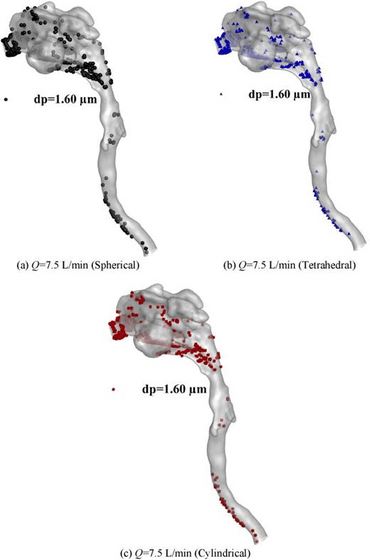Mechanism of human inhalation of microplastic particles revealed

Research that simulates the flow of air inhaled by humans by applying fluid dynamics has confirmed how microplastic particles, which are concerned about health hazards, enter the human respiratory tract.
How microplastics are transported and deposited in realistic upper airways? | Physics of Fluids | AIP Publishing
Microplastics Stick Around in Human Airways - AIP Publishing LLC
https://publishing.aip.org/publications/latest-content/microplastics-stick-around-in-human-airways/
Research and surveys to date have shown thatbeverages and food contain a large amount of microplastics, and there are also a large number of microplastic particles floating in the air, which was announced in May 2023. Estimates show that tens of kilograms of plastic fall on cities every day.
``Today's weather in Paris is rainy and sometimes plastic pollution'', the first plastic forecast predicts that 50 kg of microplastics will fall in Paris per day-GIGAZINE

Understanding the behavior of microplastics is essential for the prevention and treatment of respiratory diseases, as inhaling microplastics containing toxic pollutants and chemicals can pose serious health risks. In a study published in June 2023 in the peer-reviewed scientific journal Physics of Fluids, a research team from universities in Australia and Iran conducted calculations to analyze the movement and deposition of microplastics in the upper respiratory tract. Developed a fluid dynamics model.
Regarding the background of the research, Mohammad S. Islam of the University of New South Wales, Sydney, the lead author of the paper, said, ``Millions of tons of microplastic particles have been found in water, air, and soil. The amount of microplastics in the human body is skyrocketing, the density of microplastics in the air is also significantly increasing, and the discovery of microplastics deep in the human respiratory tract for the first time in 2022 could lead to There are now concerns about serious health damage to the population.'
Islam and his colleagues investigated how microplastics of different shapes (spherical/tetrahedral/cylindrical) and sizes (1.6/2.56/5.56 micrometers) behaved under fast and slow breathing conditions. I was. These size microplastics set in the simulation were actually found in human lung tissue by dissection.
Below is a microplastic deposition pattern in the case of slow breathing, simulating movement with a diameter of 1.6 micrometers in the shape of a sphere (upper left), tetrahedron (upper right), and cylindrical (lower). It was confirmed that when breathing slowly, fewer particles adhered to the respiratory tract than when breathing rapidly, and the distribution tended to be uniform.

As a result of repeating these simulations, it was found that microplastics inhaled by breathing concentrate and adhere to specific places such as the nasal cavity and pharynx, that is, the back of the throat. We also found that the larger 5.56-micrometer microplastic particles tended to accumulate in the respiratory tract more than smaller ones.
The authors point out that the study highlights the seriousness of the concerns posed by microplastic exposure and particle inhalation, especially in areas with high industrial activity and high levels of plastic pollution. We hope that this finding will help improve methods of health risk assessment and drug administration.
Co-author of the paper, YuanTong Gu of Queensland University of Technology, said: 'This study raises awareness of the presence of microplastics in the air we breathe and their potential impact on health. It emphasizes sexuality,' he said.
Related Posts:
in Science, Posted by log1l_ks







